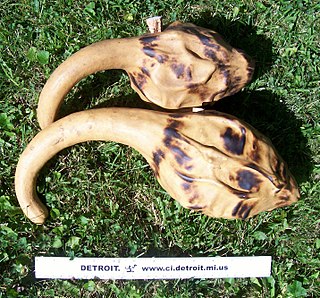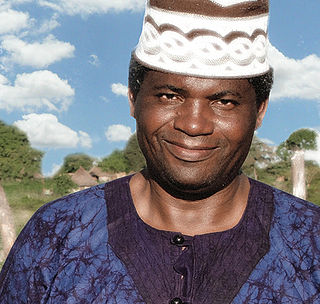Related Research Articles

In vocal jazz, scat singing is vocal improvisation with wordless vocables, nonsense syllables or without words at all. In scat singing, the singer improvises melodies and rhythms using the voice as an instrument rather than a speaking medium. This is different from vocalese, which uses recognizable lyrics that are sung to pre-existing instrumental solos.

Mbira are a family of musical instruments, traditional to the Shona people of Zimbabwe. They consist of a wooden board with attached staggered metal tines, played by holding the instrument in the hands and plucking the tines with the thumbs, the right forefinger, and sometimes the left forefinger. Musicologists classify it as a lamellaphone, part of the plucked idiophone family of musical instruments. In Eastern and Southern Africa, there are many kinds of mbira, often accompanied by the hosho, a percussion instrument. It is often an important instrument played at religious ceremonies, weddings, and other social gatherings. The "Art of crafting and playing Mbira/Sansi, the finger-plucking traditional musical instrument in Malawi and Zimbabwe" was added to the UNESCO Representative List of the Intangible Cultural Heritage of Humanity in 2020.

Zimbabwean music is heavily reliant on the use of instruments such as the mbira, Ngoma drums and hosho. Their music symbolizes much more than a simple rhythm, as the folk and pop style styled music was used as a symbol of hope for Zimbabweans looking to gain independence from Rhodesia. Music has played a significant role in the history of Zimbabwe, from a vital role in the traditional Bira ceremony used to call on ancestral spirits, to protest songs during the struggle for independence. The community in Zimbabwe used music to voice their resistance to their oppression, as one of the only weapons they had available to fight back with. In the eighties, the Music of Zimbabwe was at the center of the African Music scene thanks to genres such as Sungura and Jit. However, several performers were banned by state TV and radio leading to the closing of several music venues.

The hosho are Zimbabwean musical instruments consisting of a pair of maranka (mapudzi) gourds with seeds. They are used as major instruments in many traditional Shona music genres, such as in mbira ensembles and in mhande. They typically contain hota seeds inside them. Before the hota seeds are added, the hosho is boiled in salted water and the inside is scraped out with a corncob, newspaper plug, or woven wire. Removing the debris inside the hosho allows for a more sharp and percussive tone.

George Emanuel Lewis is an American composer, performer, and scholar of experimental music. He has been a member of the Association for the Advancement of Creative Musicians (AACM) since 1971, when he joined the organization at the age of 19. He is renowned for his work as an improvising trombonist and considered a pioneer of computer music, which he began pursuing in the late 1970s; in the 1980s he created Voyager, an improvising software he has used in interactive performances. Lewis's many honors include a MacArthur Fellowship and a Guggenheim Fellowship, and his book A Power Stronger Than Itself: The AACM and American Experimental Music received the American Book Award. Lewis is the Edwin H. Case Professor of American Music, Composition & Historical Musicology at Columbia University.
Shona music is the music of the Shona people of Zimbabwe. There are several different types of traditional Shona music including mbira, singing, hosho and drumming. Very often, this music will be accompanied by dancing, and participation by the audience. In Shona music, there is little distinction between the performer and the audience, both are often actively involved in the music-making, and both are important in the religious ceremonies where Shona Music is often heard.
Ephat Mujuru (1950–2001), was a Zimbabwean musician, one of the 20th century's finest players of the mbira, a traditional instrument of the Shona ethnic group of Zimbabwe.
Abraham Dumisani Maraire, known to friends as "Dumi", was a master performer of the mbira, a traditional instrument of the Shona ethnic group of Zimbabwe. He specialized in the form of mbira called nyunga nyunga, as well as the Zimbabwean marimba. He introduced Zimbabwean music to North America, initiating a flourishing of Zimbabwean music in the Pacific Northwest that continues into the 21st century.

The Shona people are a Bantu ethnic group native to Southern Africa, primarily Zimbabwe. They have five major clans.

Ngoma are musical instruments used by certain Bantu populations of Africa. Ngoma is derived from the Kongo word for "drum". Different Bantu-inhabited regions have their own traditions of percussion, with different names for their instruments. In Kikongo, "ngoma" is used by extension to signify specific dances, social occasions and rhythms. In Swahili, the word Ngoma is used to describe the drums themselves as well as music and dance together as a joint cultural practice.
Chirikure Chirikure alizaliwa (1962), Ni mtunzi wa mashairi, mwandishi wa nyimbo, aliehitimu chuo kikuu Zimbabwe na ni mjumbe wa chuo kikuu cha Iowa,( US). Amekuwa akifanya kazi Zimbabwe inayoongoza Kwa ushapishaji wa nyumba kama muhariri / mchapishaji Kwa muda wa miaka 17 mpaka 2002. Kwasasa anaendesha wakala wa fasihi na pia anafanya kazi, mshauri wa kitamaduni na mkalimani
In Shona music, the kushaura is the leading part. Compare with the kutsinhira part.

In Zimbabwean Shona music, a deze is a halved calabash gourd that an mbira is placed into to amplify its sound. It is typically round and has bottle caps, shells or other objects strung around its perimeter to vibrate with the mbira, creating a buzzing sound. Cracked deze frequently are repaired by wire stitching. Because of the size of the deze, audience members cannot see the mbira players' hands. Because of this, it is not uncommon for those who want to learn the mbira to play the hosho first, so that they can stand behind the players to see into deze and learn by observation. Modern deze are often constructed out of fiberglass and epoxy for increased durability. However, some mbira players, like Chartwell Dutiro, critique the use of fiberglass dezes in live performance. Dutiro says it compromises the resonance of the mbira and thus hinders communication with dza vadzimu.

Cosmas Magaya was a Zimbabwean mbira musician.

Forward Kwenda is a mbira performer from Zimbabwe. He was born in the rural Buhera area in Manicaland, an area known for its fierce resistance to colonial rulers and respect for Shona tradition. As a young boy, Forward excelled in traditional dance and recitation of ancient poetry. At the age of 10, he began to play ngoma (drums) and hosho for his mother's gombwe (rain-making) spirit. He was given the name "Forward" because of his curiosity about many subjects, enthusiastic involvement in many activities and his performances for guerrilla forces during the Rhodesian Bush War.
Dancing in Zimbabwe is an important aspect of the Zimbabwean culture, tradition, spirituality and history. There are many dances that reflect the culture of the people, although the dances may have changed throughout the years. Ethnic diversity is also a key factor in influencing the dances of the Zimbabwean culture. These dances are self-reflective, for the entire community because all music and dance are communal events. Dance to Zimbabweans is a very spiritual, powerful tool that carries on traditions, and chronicles the important events of their history and culture.
Robert Garfias is an American ethnomusicologist and musicologist. He is a professor of Anthropology and a member of The Social Dynamics and Complexity Group at the University of California, Irvine as well as a professor at the Japanese National Museum of Ethnology in Senri, Osaka.
Queen Marimba is a folk hero whose accomplishments have become part of the folklore of Africa. As is customary in most African cultures she is considered to be a god and was one of the immortals. She led the Akamba tribe in East Africa in very ancient times across the Ukambani plains in present day Kenya, stretching across the Kilimanjaro plains in present day Tanzania. There has been scant research done on her and presently the most notable source for information on her life comes from the writings of Vusa'mazulu Credo Mutwa. He asserts in his book; Indaba My Children, that she was the mother of the Akamba people at the time when they were getting to know their Maasai neighbours. Various renditions of his book have been published since the late 60's, including "My People, My Africa", "Indaba My Children" and "Africa Is My Witness."
Bira is an all-night ritual, celebrated by Shona people from Zimbabwe in which members of an extended family call on ancestral spirits for guidance and intercession. Shona people believe that the only ones who can communicate with both the living and God are the ancestral spirits, or dzavadzimu. These spirits are summoned during the Bira ceremonies through the use of music and ritual dance. Bira ceremonies are also held to welcome back the spirit of an ancestor into the home where a family member is a svikiro who is occasionally possessed by one or more ancestors.
Albert Chimedza is a Zimbabwean poet and founder of the Mbira Centre. His only collection of poetry, Counterpoint was published in 1984, together with Hopewell Seyaseya. Over the years, Chimedza has focused his energy on promoting the mbira, a unique traditional instrument that has been played for more than 1,000 years. The mbira is integral to the traditions and cultural identity of the Shona people of Zimbabwe.
References
- 1 2 "Book of Members, 1780–2010: Chapter B" (PDF). American Academy of Arts and Sciences. Retrieved June 16, 2011.